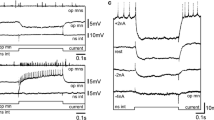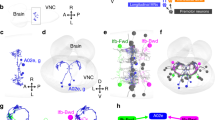Summary
-
1.
Synaptic responses of uropod motoneurons and interneurons to magnetic field stimulation of the statocyst were studied in a whole animal preparation using intracellular recording and staining techniques to characterize the descending statocyst pathways controlling uropod steering behavior.
-
2.
When the animal was engaged in abdominal postural movement, all uropod motoneurons received sustained excitatory input. Motoneurons which were to be activated during steering behavior showed excitatory responses to the stimulus superimposed on the sustained excitation. In the resting state, they showed weaker responses or no visible responses to the same stimulation.
-
3.
Motoneurons to be suppressed during steering showed inhibitory responses to the stimulus only during abdominal movement. These included both active inhibition as well as disfacilitatory suppression of excitatory input to the motoneurons.
-
4.
Premotor nonspiking interneurons, like motoneurons, showed greater responses to the stimulus during abdominal movement than at rest. Unlike motoneurons, however, they did not always receive sustained input during abdominal movement.
-
5.
Descending axons which responded to statocyst stimulation independent of abdominal movement were found in the 4th and 5th abdominal ganglia. Other axons showed greater responses during abdominal movement than at rest.
-
6.
A number of intersegmental descending interneurons with cell bodies and dendrites in the 4th or 5th ganglion were found to receive excitatory inputs from both the statocyst and the motor system controlling abdominal posture. These responses were found to summate with each other to generate spikes.
-
7.
Statocyst signals are thus transmitted to uropod motoneurons by two types of descending pathways: one whose operation is affected by the abdominal system and the other which operates independently. The former pathway functions by recruiting intersegmental abdominal interneurons and makes stronger connections with motoneurons than the latter.
Similar content being viewed by others
References
Alverdes F (1926) Stato-, Photo- und Tangoreaktionen bei zwei Garneelenarten. Z Vergl Physiol 4:699–765
Beall SP, Langley DJ, Edwards DH (1990) Inhibition of escape tailflip in crayfish during backward walking and the defense posture. J Exp Biol 152:577–582
Beltz BS, Kravitz EA (1986) Aminergic and peptidergic neuromodulation in Crustacea. J Exp Biol 124:115–141
Cattaert D, Clarac F (1983) Influences of walking on swimmeret beating in the lobster Homarus gammarus. J Neurobiol 14:421–439
Dale N, Roberts A (1985) Dual-component ammo-acid-mediated synaptic potentials: excitatory drive for swimming in Xenopus embryos. J Physiol 363:35–59
Davis WJ (1968) Lobster righting responses and their neural control. Proc R Soc Lond B 170:435–456
Davis WJ (1979) Behavioral hierarchies. Trends Neurosci 2:5–7
Edwards DH (1991) Mutual inhibition among neural command systems as a possible mechanism for behavioral choice in crayfish. J Neurosci 11:1210–1223
Grillner S (1975) Locomotion in vertebrates — central mechanisms and reflex interaction. Physiol Rev 55:247–304
Hartzell HC (1981) Mechanisms of slow postsynaptic potentials. Nature 291:539–544
Heitler WJ, Pearson KG (1980) Non-spiking interactions and local interneurons in the central pattern generation of the crayfish swimmeret system. Brain Res 187:206–211
Higuchi T (1991) Innervation pattern of some tonic muscles in the uropod of the crayfish, Procambarus clarkii. Zool Sci 8:193–196
Hisada M, Takahata M, Nagayama T (1984) Structure and output connection of local non-spiking interneurons in crayfish. Zool Sci 1:41–49
Jellies J, Larimer JL (1985) Synaptic interactions between neurons involved in the production of abdominal posture in crayfish. J Comp Physiol A 156:861–873
Jones KA, Page CH (1986) Postural interneurons in the abdominal nervous system of lobster. I. Organization, morphologies and motor programs for flexion, extension and inhibition. J Comp Physiol A 158:259–271
Knox PC, Neil DM (1991) The coordinated action of abdominal postural and swimmeret motor systems in relation to body tilt in the pitch plane in the Norway lobster Nephrops norvegicus.J Exp Biol 155:605–627
Kovac MP, Davis WJ (1980) Neural mechanisms underlying behavioral choice in Pleurobranchaea. J Neurophysiol 43:469–487
Krasne FB, Lee SC (1988) Response-dedicated trigger neurons as control points for behavioral actions: selective inhibition of lateral giant command neurons during feeding in crayfish. J Neurosci 8:3708–3712
Kreidl A (1893) Weitere Beiträge zur Physiologie des Ohrlabyrinthes.II. Versuche an Krebsen. SB Akad Wiss Wien, math-nat Kl 102:149–174
Kühn A (1914) Die reflektorische Erhaltung des Gleichgewichtes bei Krebsen. Verh Dtsch Zool Ges 24:262–277
Kupfermann I, Weiss KR (1978) The command neuron concept. Behav Brain Sci 1: 3–39
Larimer JL (1988) The command hypothesis: a new view using an old example. Trends Neurosci 11:506–510
Larimer JL (1990) Numerical and serial aspects of the interneurons controlling abdominal positioning in crustaceans. In: Wiese K, Krenz W-D, Tautz J, Reichert H, Mulloney B (eds) Frontiers in crustacean neurobiology. Birkhäuser, Basel, pp 295–300
Larimer JL, Kennedy D (1969) Innervation patterns of fast and slow muscles in the uropods of crayfish. J Exp Biol 51:119–133
Larimer JL, Jellies J (1983) The organization of flexion-evoking interneurons in the abdominal nerve cord of the crayfish, Procambarus clarkii. J Exp Zool 226:341–351
Livingstone MS, Harris-Warrick RM, Kravitz EA (1980) Serotonin and octopamine produce opposite postures in lobsters. Science 208:76–78
Miall RC, Larimer JL (1982) Interneurons involved in abdominal posture in crayfish: Structure, function and command fiber responses. J Comp Physiol 148:159–173
Miller JP, Jacobs GA (1984) Relationships between neuronal structure and function. J Exp Biol 112:129–145
Murphey RK (1973) Characterization of an insect neuron which cannot be visualized in situ. In: Kater SB, Nicholson C (eds) Intracellular staining in neurobiology. Springer, Berlin Heidelberg New York, pp 135–150
Nagayama T, Takahata M, Hisada M (1984) Functional characteristics of local non-spiking interneurons as the pre-motor elements in crayfish. J Comp Physiol A 154:499–510
Nakagawa H, Hisada M (1989) Morphology of descending statocyst interneurons in the crayfish Procambarus clarkii Girard. Cell Tissue Res 255:539–551
Neil DM, Miyan JA (1986) Phase dependent modulation of auxiliary swimmeret muscle activity in the equilibrium reactions of the Norway lobster, Nephrops norvegicus L. J Exp Biol 126:157–179
Newland PL (1989) The uropod righting reaction of the crayfish Procambarus clarkii (Girard): an equilibrium response driven by two largely independent reflex pathways. J Comp Physiol A 164:685–696
Newland PL, Neil DM (1987) Statocyst control of uropod righting in different planes of body tilt in the Norway lobster, Nephrops norvegicus. J Exp Biol 131:301–321
Okada Y, Yamaguchi T (1985) Eyestalk movements in the crayfish, Procambarus clarkii. Comp Biochem Physiol 81:157–164
Olson GC, Krasne FB (1981) The crayfish lateral giants as command neurons for escape behavior. Brain Res 214:89–100
Ozeki M, Osada S (1977) Upside-down orientation in the crayfish with ferrite statoliths during magnetic field stimulation. Annot Zool Japon 50:220–230
Ozeki M, Takahata M, Hisada M (1978) Afferent response patterns of the crayfish statocyst with ferrite grain statoliths to magnetic field stimulation. J Comp Physiol 123:1–10
Page CH (1981) Thoracic leg control of abdominal extension in the crayfish, Procambarus clarkii. J Exp Biol 90:85–100
Paul DH, Mulloney B (1985) Local interneurons in the swimmeret system of the crayfish. J Comp Physiol A 156:489–502
Pfeiffer-Linn C, Glantz RM (1991) An arthropod NMDA receptor. Synapse 9:35–42
Prentiss CW (1901) The otocyst of decapod Crustacea. Bull Mus Comp Zool Harvard 36:167–254
Rall W (1977) Core conductor theory and cable properties of neurons. In: Kandel ER (ed) Handbook of physiology sect. I: Nervous system, Vol.1: Cellular biology of neurons. Am Physiol Soc, Bethesda, pp 39–98
Reichert H, Rowell CHF (1985) Integration of nonphaselocked exteroceptive information in the control of rhythmic flight in the locust. J Neurophysiol 53:1201–1218
Roberts A (1989) A mechanism for switching in the nervous system: Turning ON swimming in a frog tadpole. In: Durbin R, Miall C, Mitchison G (eds) The computing neuron. Addison-Wesley, Wokingham, pp 229–243
Rowell CHF, Pearson KG (1983) Ocellar input to the flight motor system of the locust: structure and function. J Exp Biol 103:265–288
Schöne H (1954) Statocystenfunktion und statische Lageorientierung bei dekapoden Krebsen. Z Vergl Physiol 36:241–260
Schöne H, Neil D, Scapini F, Dreissmann G (1983) Interaction of substrate, gravity and visual cues in the control of compensatory eye responses in the spiny lobster, Palinurus vulgaris. J Comp Physiol 150:23–30
Silvey GE, Sandeman DC (1976) Integration between statocyst sensory neurons and oculomotor neurons in the crab Scylla serrata. IV. Integration phase lags and conjugate eye movements. J Comp Physiol 108:67–73
Soffe SR, Roberts A (1982) Tonic and phasic synaptic input to spinal cord motoneurones during fictive locomotion in frog embryos. J Neurophysiol 48:1279–1288
Stein A, Schöne H (1975) Über das Zusammenspiel von Schwereorientierung und Orientierung zur Unterlage beim Flußkrebs. Verh Dtsch Zool Ges 65:225–229
Stewart WW (1978) Functional connections between cells as revealed by dye-coupling with a highly fluorescent naphthalimide tracer. Cell 14:741–759
Takahata M (1990) The crayfish posture control system as a model for studying mechanisms underlying behavioral variability. In: Wiese K, Krenz W-D, Tautz J, Reichert H, Mulloney B (eds) Frontiers in crustacean neurobiology. Birkhäuser, Basel, pp 301–308
Takahata M, Hisada M (1982) Statocyst interneurons in the crayfish Procambarus clarkii Girard. I. Identification and response characteristics. J Comp Physiol 149:287–300
Takahata M, Hisada M (1985) Interactions between motor systems controlling uropod steering and abdominal posture in crayfish. J Comp Physiol A 157:547–554
Takahata M, Hisada M (1986) Local nonspiking interneurons involved in gating of the descending motor pathway in crayfish. J Neurophysiol 56:718–731
Takahata M, Komatsu H, Hisada M (1984) Positional orientation determined by the behavioural context in Procambarus clarkii Girard (Decapoda: Macrura). Behaviour 88:240–265
Takeuchi A, Takeuchi N (1964) The effect on crayfish muscle of iontophoretically applied glutamate. J Physiol 170:296–317
Tatsumi H, Haragashira M, Suzuki R (1985) Interrelations between posture and locomotion in response to body rotation in crayfish. J Comp Physiol A 157:509–517
Toga T, Takahata M, Hisada M (1990) An identified set of local nonspiking interneurones which control the activity of abdominal postural motoneurones in crayfish. J Exp Biol 148:477–482
Van Harreveld A (1936) A physiological solution for fresh water crustaceans. Proc Soc Exp Biol Med 34:428–432
Wiersma CAG, Yamaguchi T (1967) Integration of visual stimuli by the crayfish central nervous system. J Exp Biol 47:409–431
Yoshino M, Takahata M, Hisada M (1980) Statocyst control of the uropod movement in response to body rolling in crayfish. J Comp Physiol 139:243–250
Author information
Authors and Affiliations
Rights and permissions
About this article
Cite this article
Takahata, M., Murayama, M. Multiple gate control of the descending statocyst-motor pathway in the crayfish Procambarus clarkii Girard. J Comp Physiol A 170, 463–477 (1992). https://doi.org/10.1007/BF00191462
Accepted:
Issue Date:
DOI: https://doi.org/10.1007/BF00191462




